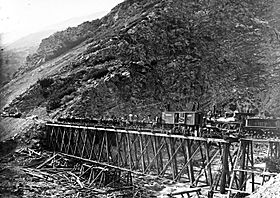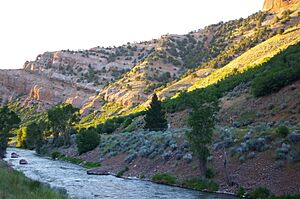Weber Canyon facts for kids
Quick facts for kids Weber Canyon |
|
|---|---|

The building of Devil's Gate Bridge in Weber Canyon, 1869
|
|
| Traversed by | |
Weber Canyon is a cool canyon in Utah, located in the Wasatch Range mountains. The Weber River flows right through it, heading west towards the Great Salt Lake. This canyon is about 40 miles (64 km) long and has 13 smaller creeks that flow into the main river.
Contents
A Look Back in Time
Weber Canyon has a really interesting history in Utah. Long, long ago, before written records, Native American tribes like the Shoshone and Ute lived in this area. They were nomadic, meaning they moved around a lot, and the many streams feeding the Weber River made it a great place for them to live and find food.
Early Explorers and Trappers
The canyon and river are named after a fur trapper named John Henry Weber. Other early explorers, like Étienne Provost, also visited the area. In 1825, near a place now called Mountain Green, a group of British fur trappers from the Hudson's Bay Company, led by Peter Skene Ogden, met some American trappers led by Johnson Gardner. Gardner believed the British group was on United States land. Ogden managed to keep the situation calm, even though some of his men joined Gardner's group.
Wagon Trails and Railroads
In 1846, people traveling to California in wagons, including the Hudspeth, Bryant-Russell, and Young and Harlan groups, were the first to take wagons through Weber Canyon. The first road through the canyon was finished in 1855 by a group led by Thomas J. Thurston. Later, in 1868, Brigham Young made a deal with the Union Pacific Railroad to build part of the transcontinental railroad right through Weber Canyon.
Cool Sights to See
Today, Interstate 84 travels through Weber Canyon. As you drive, you can see an unusual rock formation called Devil's Slide.
You can also find the 1000 Mile Tree here. This pine tree was discovered by Union Pacific Railroad workers because it marked 1,000 miles (1,600 km) from where the railroad started in Omaha, Nebraska. The first tree died in 1900. In 1982, to remember the spot, Union Pacific planted a new tree that is now over 30 feet (9.1 m) tall!



